We have explored only a small part of the history of data visualization. What possibilities can we imagine when we expand our view of the past?
Elizabeth Palmer Peabody was born in 1804, within only a year or two of Shanawdithit. But her life circumstances—the stability of food and family, her membership in the Boston intellectual elite, and the gift of good health—enabled her to live for nearly a century. By the time that she died, in 1894, she left her mark on any number of fields. But in the early 1850s, at the prime of her life, Peabody set out from her home in Boston to ride the rails. She traveled as far north as Rochester, NYRochester, NY ; as far west as Louisville, KYLouisville, KY ; and as far south as Richmond, VARichmond, VA , in order to promote the pair of history textbooks she had recently written, The Polish-American System of Chronology (1850) and A Chronological History of the United States (1856). In the textbooks, Peabody described a new method of visual learning—the Polish-American system, she came to call it—a method with data visualization at its core.
Today, Peabody is still most widely recognized for her proximity to more famous men—in particular, to the writers of the American Renaissance, such as Ralph Waldo Emerson and Nathaniel Hawthorne, and to early champions of educational reform, such as Bronson Alcott and Horace Mann. She is certainly not accorded a prominent place in any major history of data visualization. But her contributions to each of these areas, including visualization, were substantial. The bookstore that she ran out of her home, at Boston's 13 West Street, functioned as the de facto salon for the transcendentalist movement. She edited and published the first version of Henry David Thoreau's essay on civil disobedience. She can be credited with starting the first kindergarten in the United States. And, as this chapter will assert, she offered a transformative view of the uses and value of data visualization, one which challenges the teleological account of the field's emergence, as well as the epistemological assumptions that—as a result of this account—have become embedded in the field.
An additional anecdote helps to elaborate this point. When Peabody boarded the train at Kneeland Street Station, on the southern edge of downtown, along with boxes of the textbooks that she hoped to sell, she also traveled with a rag-paper roll between five and six feet long. The roll was comprised of a stack of large-scale replicas of the data visualizations, pictured above, that appeared in the books. Peabody identified the charts, with their vibrant geometric abstraction, as key components of her visual epistemology. As she later recalled, the charts were “intended to do for the science of history what maps do for that of geography; and… [make it] easy to lay the foundations of historical knowledge in the minds of the young.” Like Thomas Clarkson, William Playfair, and other early proponents of data visualization, Peabody recognized the power of visual perception to crystalize the insight that leads to new knowledge. But she wielded that power in a very different way. Peabody designed her charts to be abstract rather than intuitive; to promote sustained reflection rather than immediate insight. And she did so with a clear goal in mind: to provoke a unique imaginative response in each viewer.
In this way, Peabody and her charts offer an epistemological alternative to the dominant view of how visualization leads to new knowledge—the one advanced explicitly by Clarkson and Playfair, and implicitly by Cormack in his request that Shanawdithit produce her charts. As this chapter will show, Peabody's is a feminist epistemology avant le lettre. This is not because Peabody herself was a woman—although this chapter will also discuss some of the reasons for the gender skew of the history of the field. Rather, by repositioning the source of the insights that lead to new knowledge from the visualization itself to its interplay with the viewer, she flattens the hierarchy that more commonly structures the relationship between the designer of a visualization and those who perceive it. This is a feminist theoretical move, as we have already begun to explore through the lens of the “god trick” in Chapter One.
But in addition, Peabody's strategic use of abstraction, and—as we have already begun to learn through the example of her “mural charts,” as she called her large-scale visualizations—her involvement of the whole body, Peabody's charts challenge additional hierarchies that remain entrenched in visualization design, particularly those that place purportedly “objective” representational strategies above those that encourage more affective and embodied ways of knowing. This is also a feminist move; in their rejection of the belief that every phenomenon in the world can be easily captured and rendered visible by data, Peabody's charts attune us to the multiple ways by which visualization can lead to new knowledge, as well as to the multiple ways in which we might understand the nature of knowledge itself.
These are not small contributions. And yet, there is more we might learn from Peabody and her charts. If there is an overarching lesson of this chapter, it is that they are but one set of examples of the many missing figures—and many missing forms—that we might incorporate into the story we tell about the emergence of modern data visualization. Here we might also recall the idea of starting with the shuffle, from this project's Introduction, and remind ourselves that we can—and should—always shuffle again. For the impact of this action is profound: it contributes not only to an ever-expanding set of examples that enrich our sense of the history of data visualization, but also an expanded set of possibilities for shaping its future.
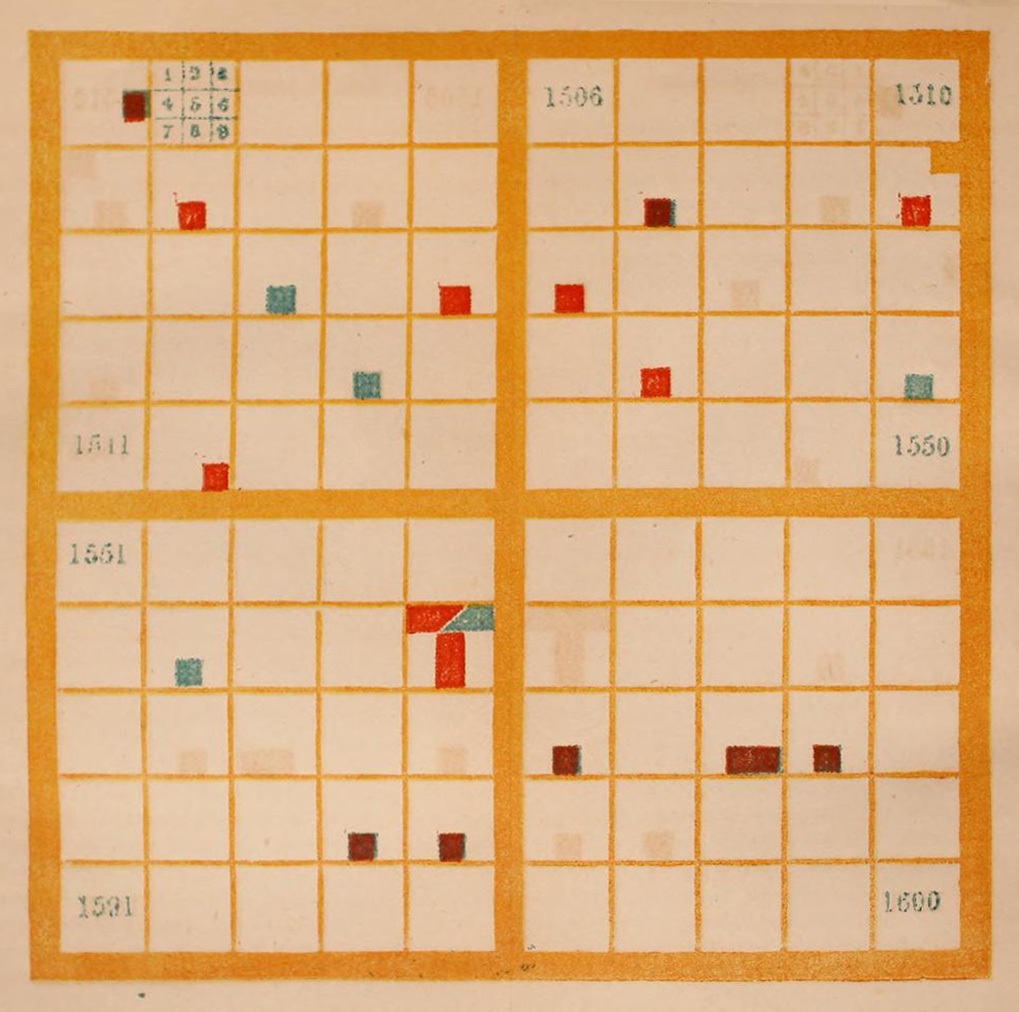
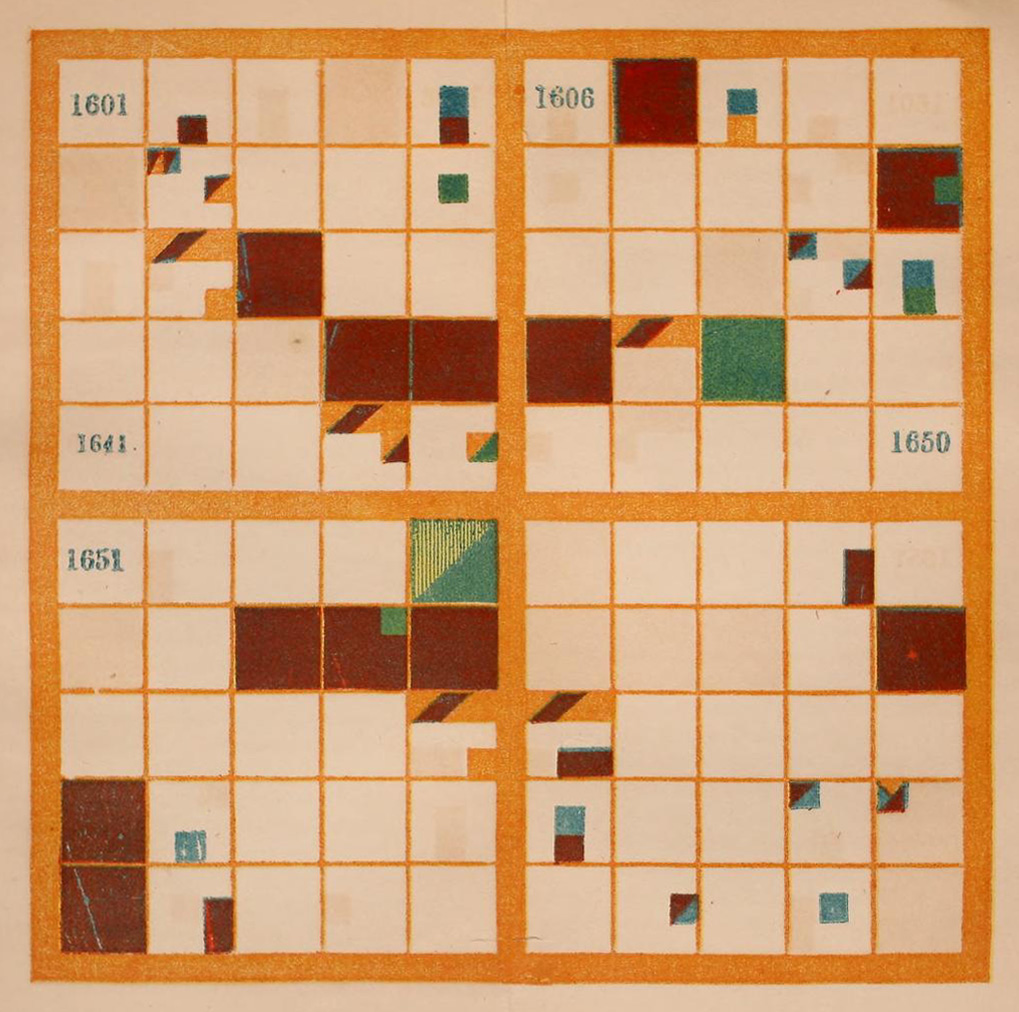
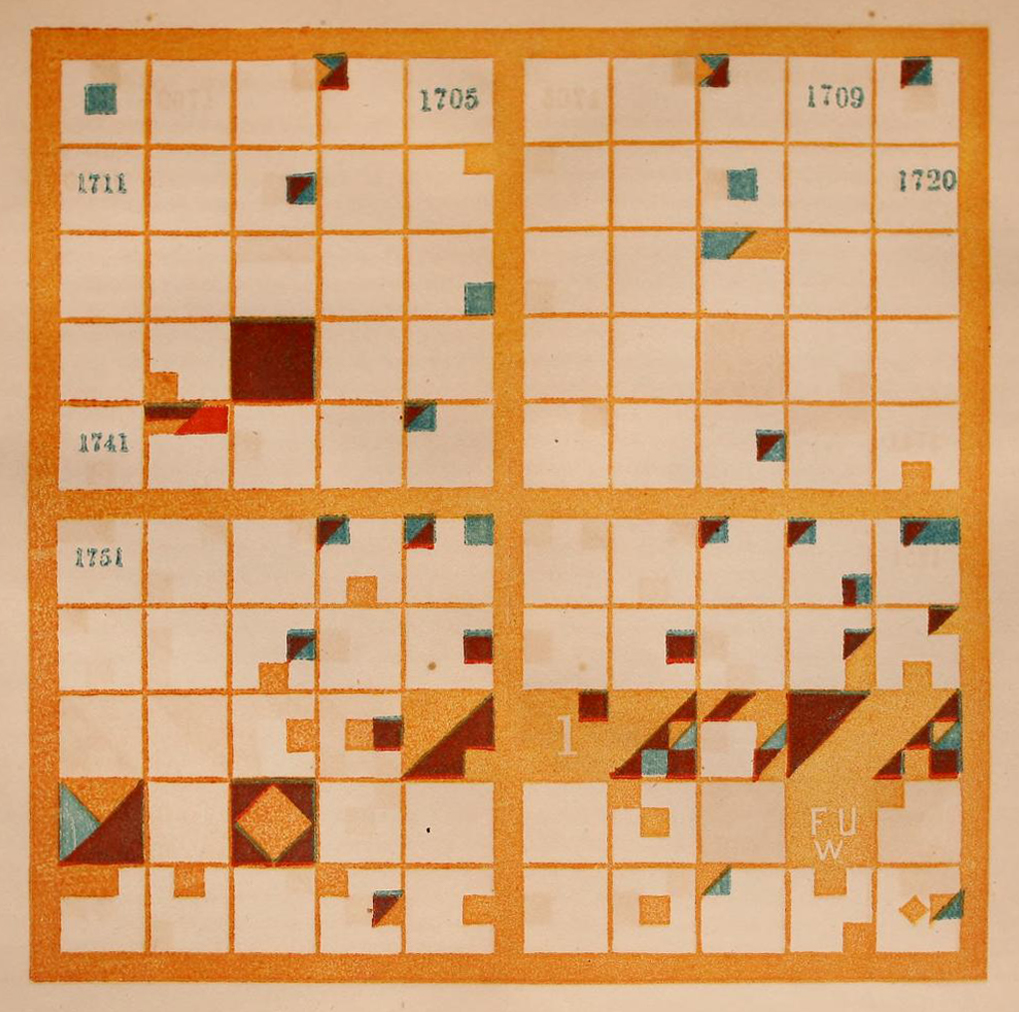
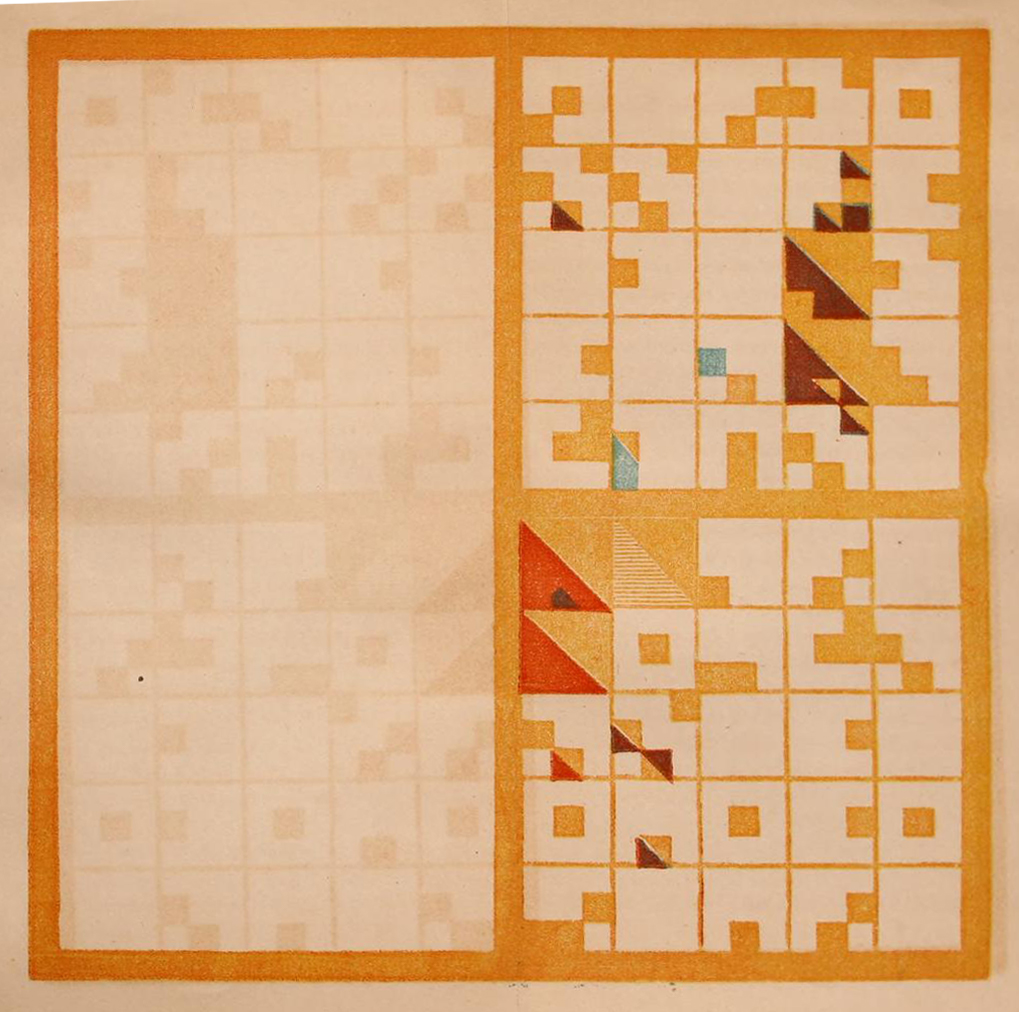
Peabody's method of visualizing events of historical significance was inspired by a system developed in Poland in the 1820s, and popularized in subsequent decades by the military general (and erstwhile math teacher) Jósef Bem.Bem's system employed a grid overlaid with shapes and colors to visually represent events in time. In Cartographies of Time: A History of the Timeline, Daniel Rosenberg and Anthony Grafton describe how the system "swept across Europe and North America" in the middle decades of the nineteenth century.But Peabody first encountered the system by chance: through a traveling lecturer who briefly boarded with her family on West Street. The boarder, a man named Joseph Podbielski, had come from Poland with copies of Bem's charts, which he intended to promote on a lecture tour of the United States. While he soon departed the family's residence, Peabody remained "captivated" by the charts, according to one of her biographers, Bruce Ronda.She went on to devote several years to a study of the Polish System, culminating with the development of her own modified version: the Polish-American System that prompted her own national tour.
In The Polish-American System of Chronology , Peabody covers a tremendous expanse of time: the period between 2500 BCE and the present (1849 CE). But Peabody also saw the need for a textbook that focused exclusively on the United States, and that went into more detail than she could cover in a textbook on world history. And so, shortly after the release of the Polish-American System, she began working on the book that would be published, in 1856, as A Chronological History of the United States. This textbook contained the four full-color plates displayed above; one for each of the centuries since the first European colonizers set foot on Native American land. As Peabody envisioned it, the basic exercise was to read a chapter of the textbook, which contained a narrative account of the events of a single century, and then match each item in the list of events that concluded the chapter with its visual representation on the corresponding chart.
Peabody’s system borrows from Bem the idea of a numbered grid, with each year in a century marked out in its own square.
She also borrows the idea of subdividing each square, so that each of the nine interior squares corresponds to a particular type of historical event.
In the Polish-American system, as in Bem’s, the top left corner is the space for wars, battles, and sieges; in the top middle is the space for conquests and unions; in the top right is the space for losses and divisions, and so on.
- Battles, Sieges, Beginning of War
- Conquests, Annexations, Unions
- Losses and Disasters
- Falls of States
- Foundations of States and Revolutions
- Treaties and Sundries
- Births
- Deeds
- Deaths, of Remarkable Individuals
The events are also color-coded, indicating the various countries involved in a particular event. On this point, Peabody makes special note that she employs "a somewhat different, and, as it seems to me, a more expressive distribution of colors."
When an entire year is shaded a single color, it indicates an event of such magnitude or complexity that the other events in that year literally pale in comparison.
For example, the square for 1607 is entirely red, marking the settlement of Jamestown, the first permanent British colony in the Americas.
In 1620, we see two events. More significant, for Peabody, is the settlement of Plymouth by the Pilgrims.
2. Conquests, Annexations, Unions
England Holland
But she also marks the first enslaved Africans being brought to Jamestown, shaded in teal to indicate that they arrived aboard a Dutch ship. On the side of abolition but by no means its most radical proponent, the square's outsized ratio of red to teal reflects Peabody's awareness of—if not an urgency about—the need to end slavery in the United States.
6. Treaties and Sundries
England Holland
Elsewhere on the chart, Peabody uses diagonals to show events that involve two or more nations.
In 1622, we see a representation of the series of deadly conflicts between the Powhatan people and the Jamestown settlers. First, in the position that indicates battles, sieges, and beginnings of war, we see the attack by the Powhatan on the Jamestown colony that John Smith documented in his history of Virginia. Peabody labels this the “Jamestown Massacre.” In the top left of the square is gold, the color for the Americas, here representing the Powhatan and their position as initiators of this particular battle. In the bottom right is red, representing the British settlers, in their position as besieged.
1. Battles, Sieges, Beginning of War
England Americas
In the next square over—the position that indicates conquests, annexations, and unions—the colors are reversed, indicating retaliation by the British on the Powhatan. In the textbook, this is labeled “Assault on Powhatan Settlements.”
2. Conquests, Annexations, Unions
England Americas
Peabody shades the final square in the row, for losses and disasters, entirely gold. The accompanying text reads “Indians are conquered.”
3. Losses and Disasters
Americas
In the same year, we see a teal square in the bottom left, the position representing “deaths of remarkable individuals.” Peabody tells us this represents the death of Pocahontas, the daughter of Chief Powhatan himself. It is unclear as to why this square is shaded in the color representing Holland, as Peabody indicates in the text that she died in England. Another inconsistency is the year of death, which scholars now date five years earlier, to 1617.
9. Deaths, of Remarkable Individuals
Holland
Chronology—or, the study of events in time—is not, of course, the same as historiography—the study of how history is written. But in Peabody's mind, the one led to the other: "If you have the dates here [on the charts] represented perfectly by heart," as she explains in the introduction to students included in the Chronological History, "events are so connected in the narrative of history."In keeping with the leading pedagogical theories of the day, which emphasized mental recall, students were expected to commit the charts to memory.But Peabody's approach diverged from the rote memorization that characterized most mid-nineteenth-century classrooms in that her ultimate aim was for each student's mental picture of past events to prompt a richer—and, crucially, and individually-constructedn—narrative of history. For Peabody, the power of this personal narrative of history was immense: it could show "the origin and consequences of national action"; and for the US in particular—the world's first representative democracy—it could instruct "every one what to do and what to leave undone, in his own inevitable action," as a necessary participant in their own governance.
Far from an antiquated line of thinking, Peabody's belief in the catalyzing effects of chronology remains deeply embedded in US culture today. As a prominent example, one might consider the efforts of New York Times journalist Nikole Hannah-Jones to replace 1776 with 1619—contra Peabody, the year the first enslaved Africans actually arrived in Virginia—as the starting point for the history of the United States. The goal of this revised origin point, as Hannah-Jones explains in the visual feature that introduces the 1619 Project, is to "reframe the country's history by placing the consequences of slavery and the contributions of black Americans at the very center of our national narrative."This recentered narrative would ideally, in turn—in a view endorsed by the Times editorial board—prepare US citizens of all races "for a more just future."
But it is not only the narrative of the nation's founding that can benefit from a recentering of the enduring costs of its legacy of slavery, or of the contributions made by its Black citizens. In her acclaimed recent book, Dear Science and Other Stories, Black studies scholar Katherine McKittrick takes on the project not of history but of science, explaining how an account that centers Black people, Black life, and Blackness more broadly can reveal the "asymmetrically connected knowledge systems" that structure modern scientific inquiry.For McKittrick, an awareness of the range of related yet unequally weighted knowledge-making systems is what enables her own vision of a liberatory Black science to unfold. But the truth is that all of our ways of knowing are shaped by asymmetrical power, and data visualization is no exception. We have already seen a related argument in Chapter One, which engaged feminist philosopher Donna Haraway's ideas about the “god trick.” Crucially for Haraway, as for McKittrick, our awareness of how knowledge is situated, as Haraway would say (or how knowledge is relational, as perhaps would McKittrick), does not diminish the validity of what we presently know, nor does it foreclose any future knowledge-making. On the contrary, these more nuanced understandings of the perspectives and places from which knowledge is made are precisely those on which, to quote Haraway, “the possibility of sustained, rational, objective inquiry rests.”
With a renewed sense of the value of multiple perspectives in contributing to what we know, we might return to Peabody's chronological charts with the observation that few twenty-first-century viewers—or, for that matter, nineteenth-century ones—could have intuited the significance of the events encoded in the charts without first taking the time to learn how the system worked.This lengthy and difficult learning process might be viewed as a liability by those who continue to champion the ease and efficiency of visualization; or those who maintain that data visualization is best deployed to amplify already existing thought processes. In support of this perspective, consider the representation of the events encoded in Peabody's chart of the seventeenth century as a timeline, shown just below. The progression of events over the course of the century, culminating in a series of wars and rebellions in the late 1680s and early 1690s, becomes much more immediately legible as compared to the top-to-bottom, left-to-right layout of the grid.
But for Peabody, her charts' near-total abstraction was precisely the point. She designed her charts to appeal to the senses directly, to provide what she called "outlines to the eye."Her hope was that, by providing the outline of history—and, crucially, only the outline—each viewer could fill in the missing parts of the story themselves.The result would be a proliferation of historical narratives, one originating in the mind of each viewer, and reflecting their own interpretation of the chart. Anticipating claims about both the situated and relational nature of knowledge production, Peabody's visualization system relocates the source of the insight that leads to new knowledge from the image to the viewer. What's more, it affirms each interpretation of each image as an additional source through which our collective knowledge can continue to grow.
Visualizing Time
The Peabody Chart as Bar Graph
Hover over an event
- Battles, Sieges, Beginning of War
- Conquests, Annexations, Unions
- Losses and Disasters
- Falls of States
- Foundations of States and Revolutions
- Treaties and Sundries
- Births
- Deeds
- Deaths, of Remarkable Individuals
Peabody was a lifelong proponent of what might be described today as participatory learning. In the early 1860s, as the nation became increasingly consumed by the Civil War, Peabody found personal comfort in a recommitment to early childhood education. Her kindergarten—as mentioned, the first of its kind in the United States—which she opened with her sister, Mary Tyler Mann, served as a proving ground for her innovative pedagogical ideas. With her sister, she also published a series of essays documenting the theories they enacted in the classroom. And on her own, Peabody continued to iterate on the teaching and learning materials associated with the Polish-American system.
In 1870, Peabody began printing workbooks with sheets of blank charts—"blank centuries,” as she called them—so that students could themselves create the visualizations that they would then study. In the interaction below, we've adapted this participatory process for the screen. But be forewarned, the exercise of creating a chronological chart from scratch is quite hard, as each of us on the project team can personally confirm. On the bottom left of the screen, you can also click “end” to skip ahead.
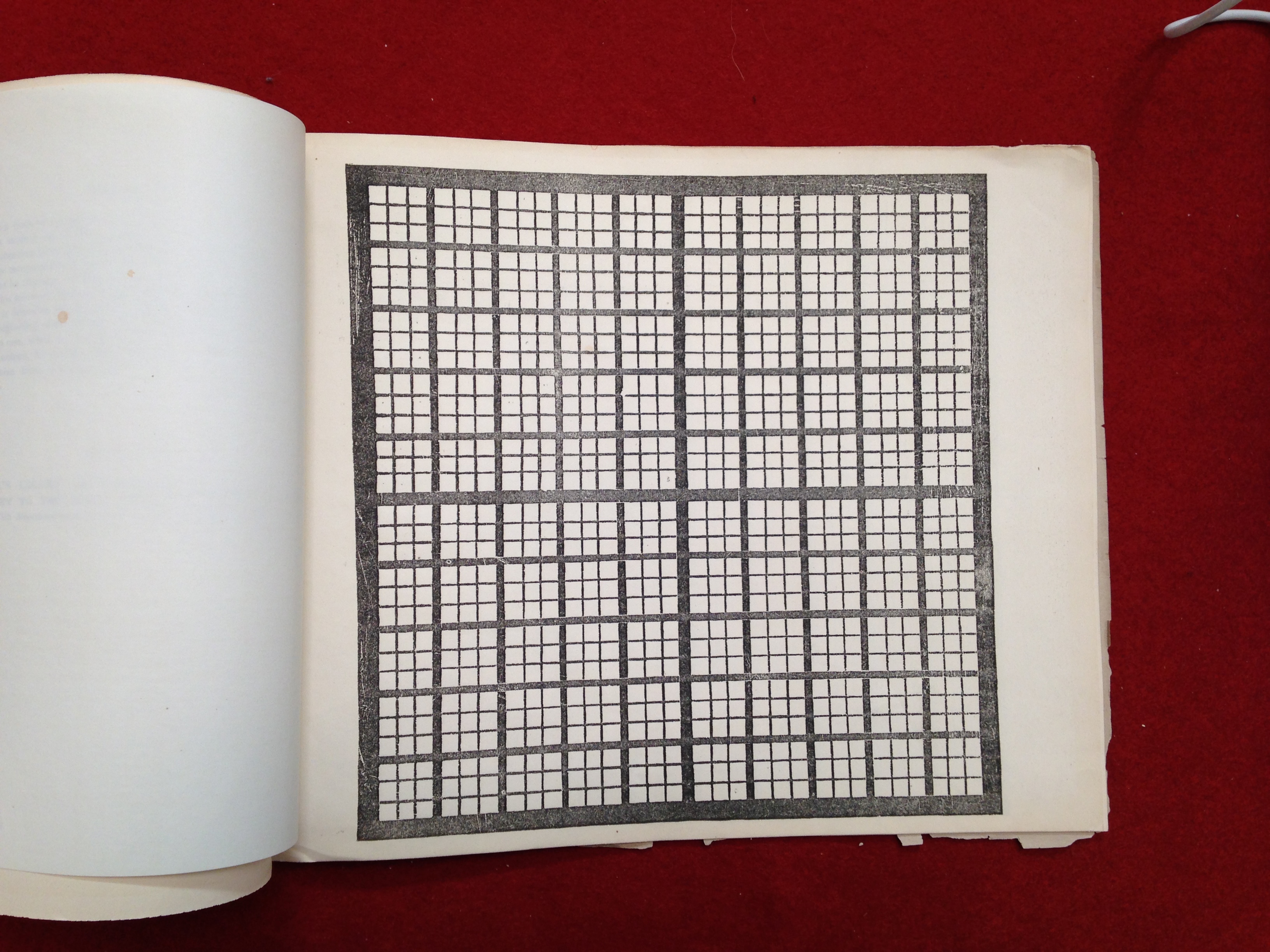
Once you've learned to recognize the Gold and Burgundy triangles as visual representation of Indigenous and colonial conflict.
You come to see how the 17th century is increasingly dominated by similar conflicts, documenting the devastation brought about by British colonial expansion
EVENT 1 of 4
CONTINUE READING
If you, like all of us, found this exercise virtually impossible, rest assured that the difficulty level was high for students of the nineteenth century as well. Peabody's nephew, Julian Hawthorne, who served as her first test subject, recalled that she “labored during some years to teach me all the leading dates of human history,” but that he nevertheless remained “most inapt and grievous” throughout the process.The evidence in the archive confirms this first-hand account. At the American Antiquarian Society, the Library Company of Philadelphia, Yale's Beinecke Library, and Princeton's Special Collections can be found multiple copies of Peabody's workbooks, many of which I've personally paged through over the course of conducting research for this project. The workbooks all tend to follow a similar pattern: a page or two of grids filled out in earnest; then a series of attempts abandoned halfway; and then a shift in purpose, the grid becoming a canvas for pattern and unbridled play.
Again, the difficulty of the Polish-American system is both a liability of the form and also the point. Peabody first developed her method at a time when the nation's future seemed to hang in balance. The second half of the 1840s had brought an increased awareness of the nation's growing sectarianism, as well as its range of social ills--albeit with a (mostly) optimistic view about the potential of its governing structures to address these challenges. But as the 1850s unfolded, the magnitude of these challenges became increasingly more pronounced. Even as her privilege protected her from having to enter the political fray, Peabody recognized that the task of resolving the underlying issue of sectarianism, not to mention the moral obligation of ending slavery, posed a degree of difficulty of the highest order. Peabody understood, moreover, that any successful resolution of these conflicts would require a consideration of a range of possible paths forward, as well as sustained effort and deep thought.
Peabody’s goal with the Polish-American system was to create a framework, equal parts pedagogical and epistemological, through which this difficult thinking could take place. “The old world is covered with bad institutions which men have created, very often with positively good intentions, but on false notions, or, at least, without large and profound ideas,” she explains in the preface to the Chronological History. “Whether the new world shall estimate and sift out these evils, or repeat these mistakes, depends on young Americans, who are now sitting in schoolrooms all over the country, unconscious of their powers and consequent responsibilities.”Her hope was that the act of creating the chronological charts, rather than simply studying them, would prompt both self-reflection and new ideas. Put another way: Peabody hoped that by prompting her students to create new narratives of the past, they would also imagine alternative possible futures.
The historical and political context that provided Peabody with the motivation to publish her textbooks is crucial for understanding both her ideas about the uses of visualization, and the form that her visualizations take. We have already seen several other examples of this. In Chapter Two, we learned how Playfair's time-series charts were born of a desire to communicate a big picture view to “men of high rank” who did not have time to concern themselves with the details. In Chapter Three, we considered how Emma Willard's choice to put a map of the United States in the background of her visualization of the sizes and location of Indigenous peoples accorded it the status of established fact, rather than its still-contested reality. So as to continue to draw out the convergence of Peabody's epistemology with her pedagogy and her political ideology, we will now turn to one of Willard's later charts which helpfully puts its own ideology on the surface.
Willard'sTemple of Time, which she designed in 1846 after nearly two decades of continual experimentation with ways of visualizing history, depicts past centuries as the pillars that support the titular temple. In the chart, the nineteenth century is represented as an unfinished column, not yet stable enough to support the weight of the past. On the ceiling of the temple, Willard catalogues key figures from each prior century, including statesmen, philosophers, discoverers, and poets. On the floor of the temple, she lays out the developments of major nation-states, their paths drawn as rivers subjected—like water levels—to the expansions and contractions of state power over time. Consistent with the narrative enacted by her maps, Willard places the path of the United States front and center. From the perspective of the viewer, this river flows directly towards them, enfolding them in the expanding influence of the United States: the future to come.

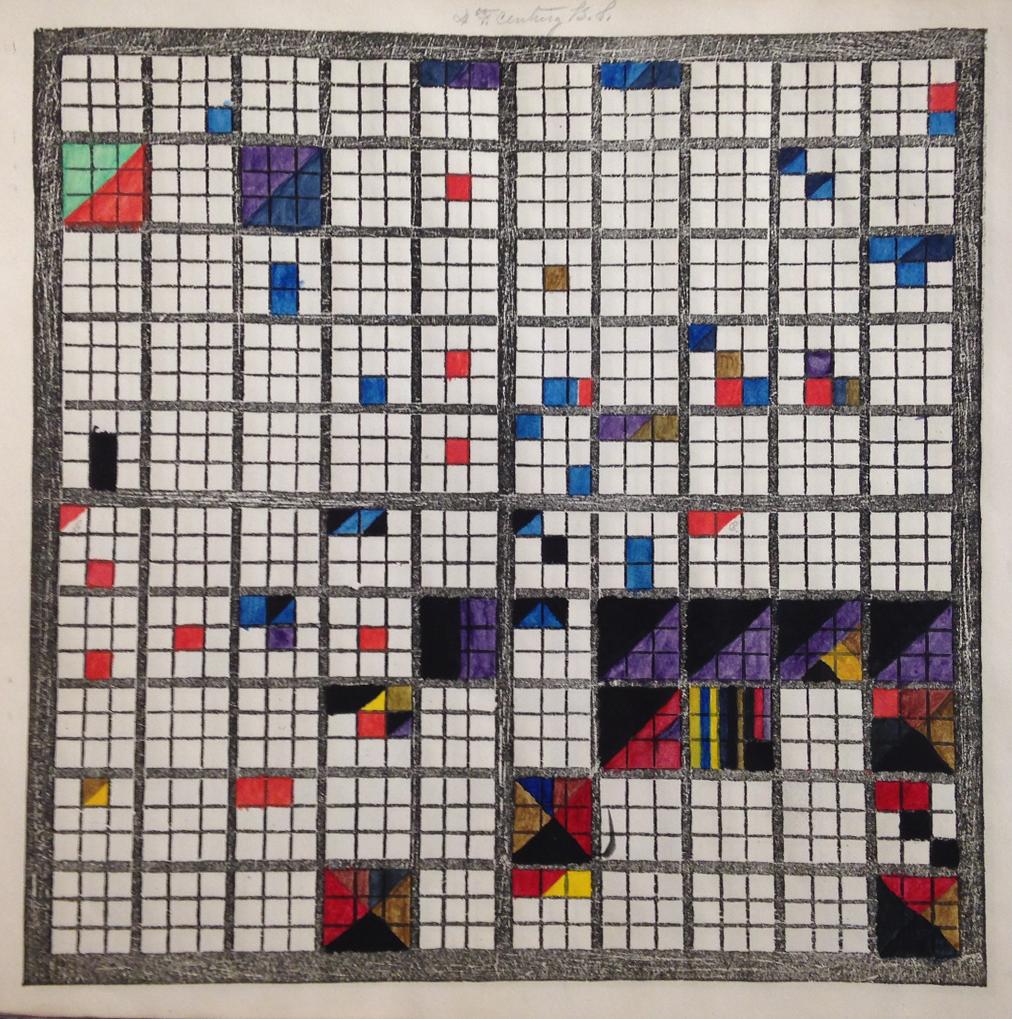
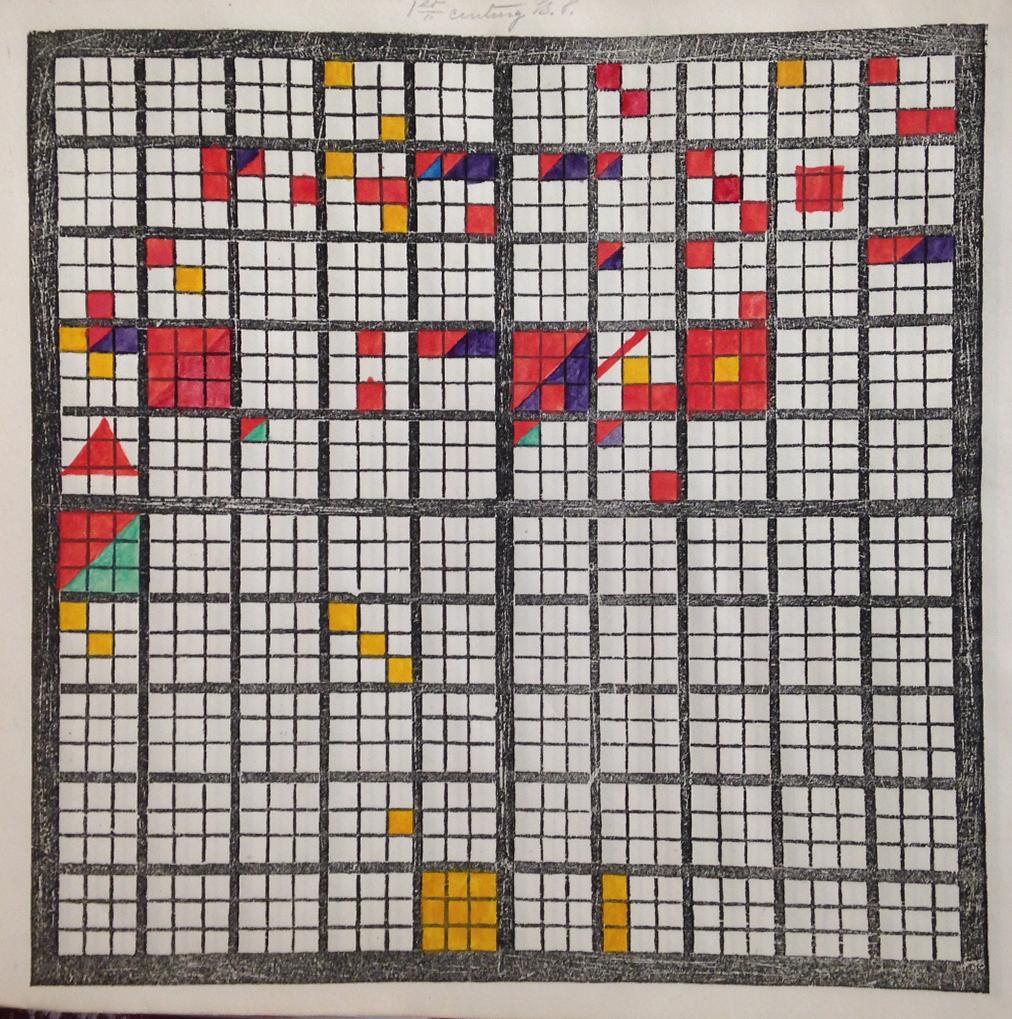
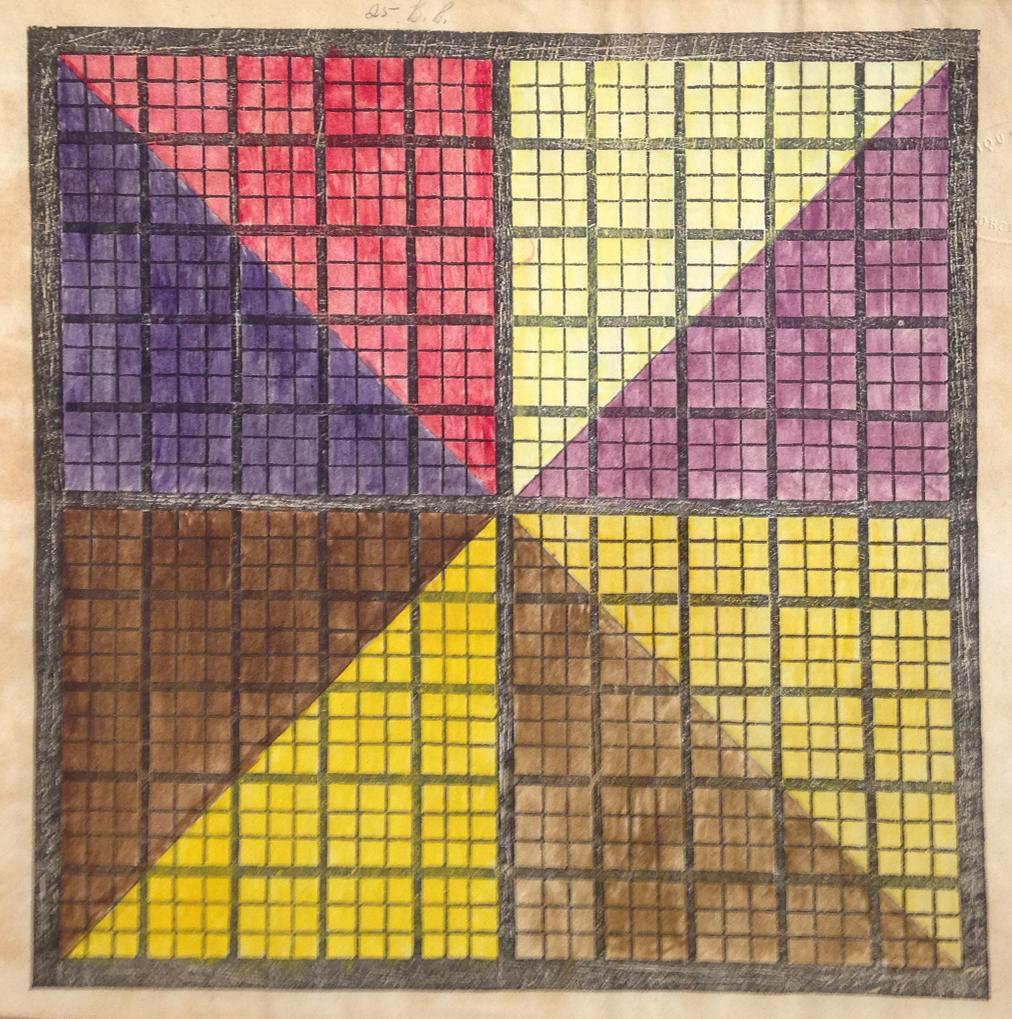
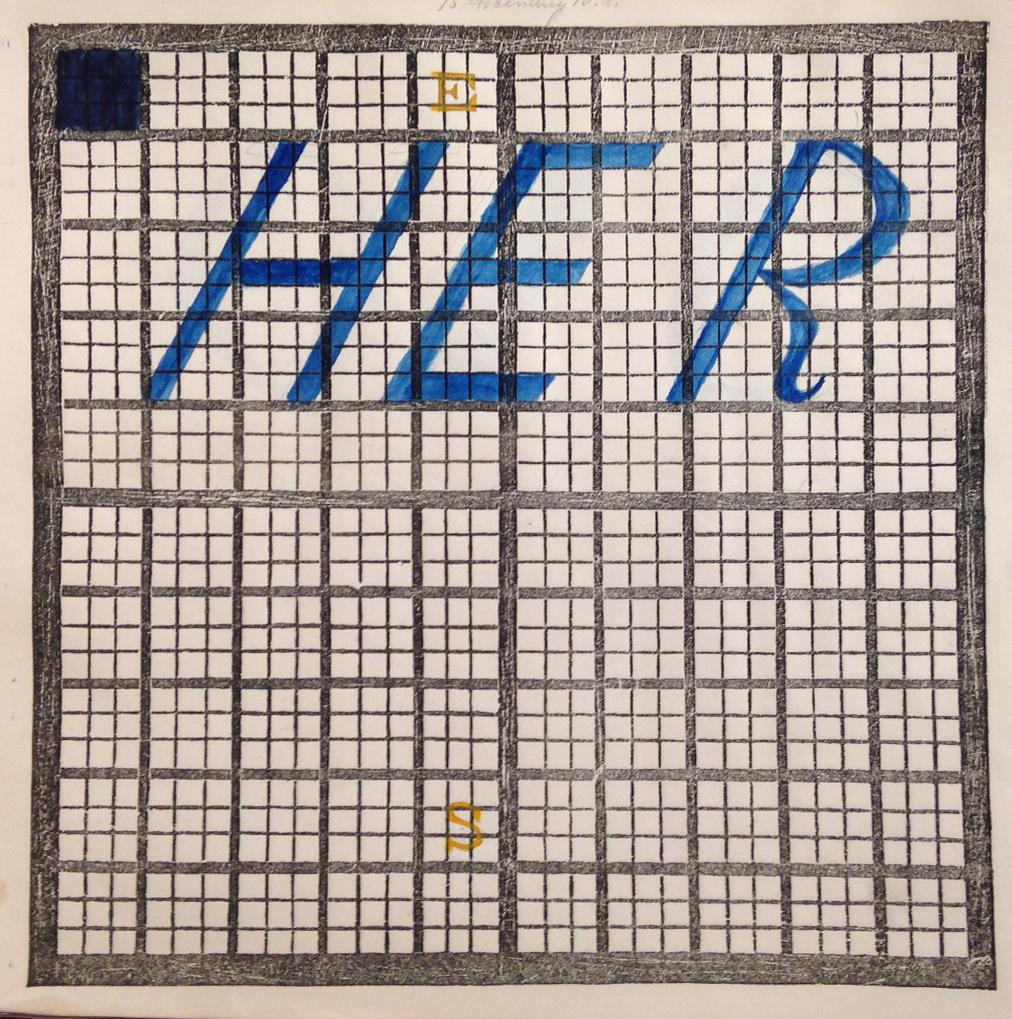
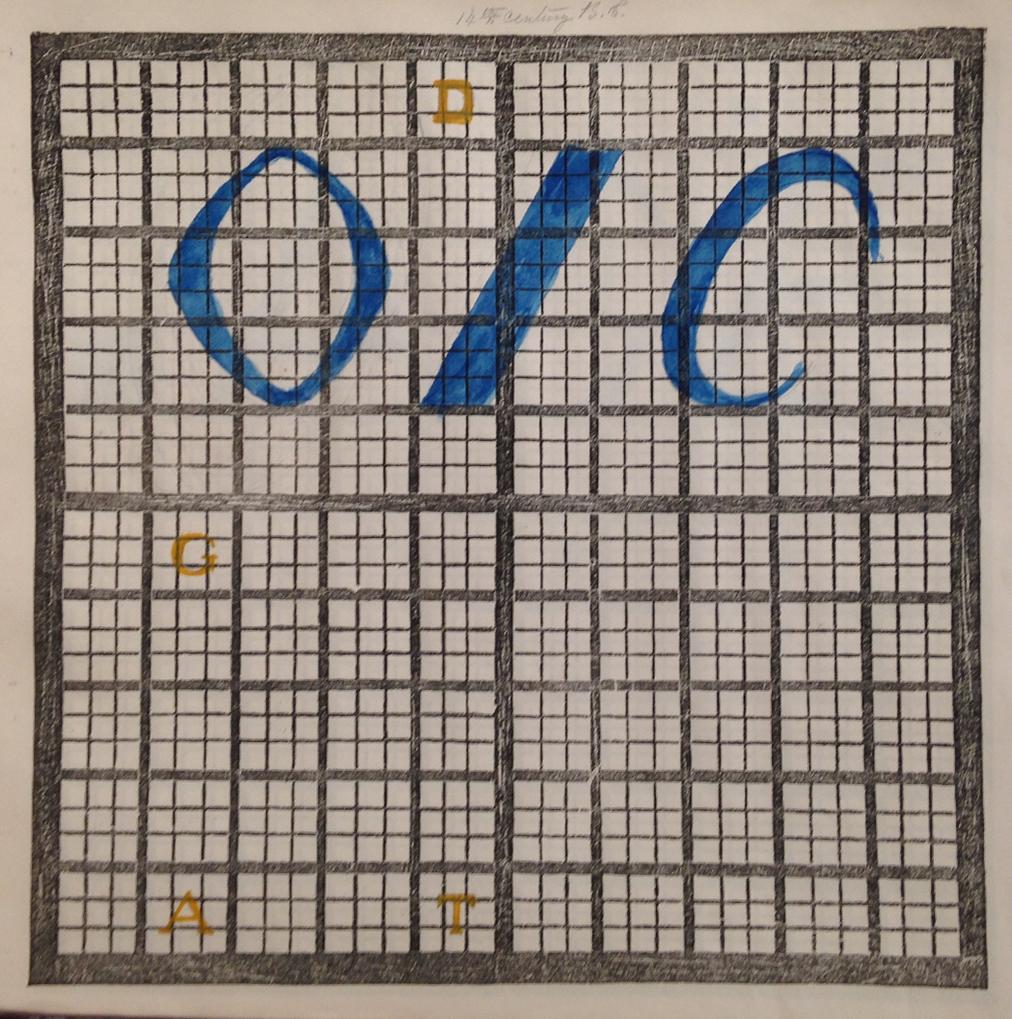
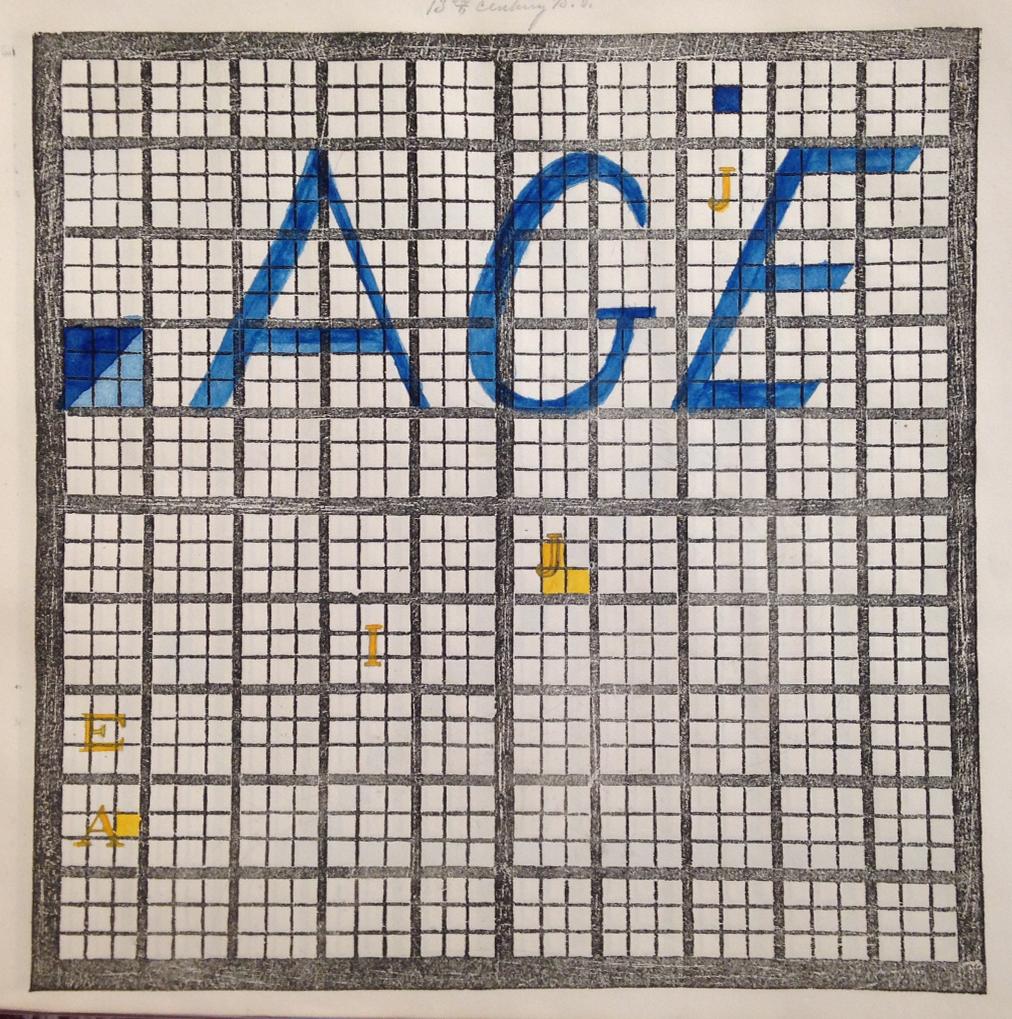
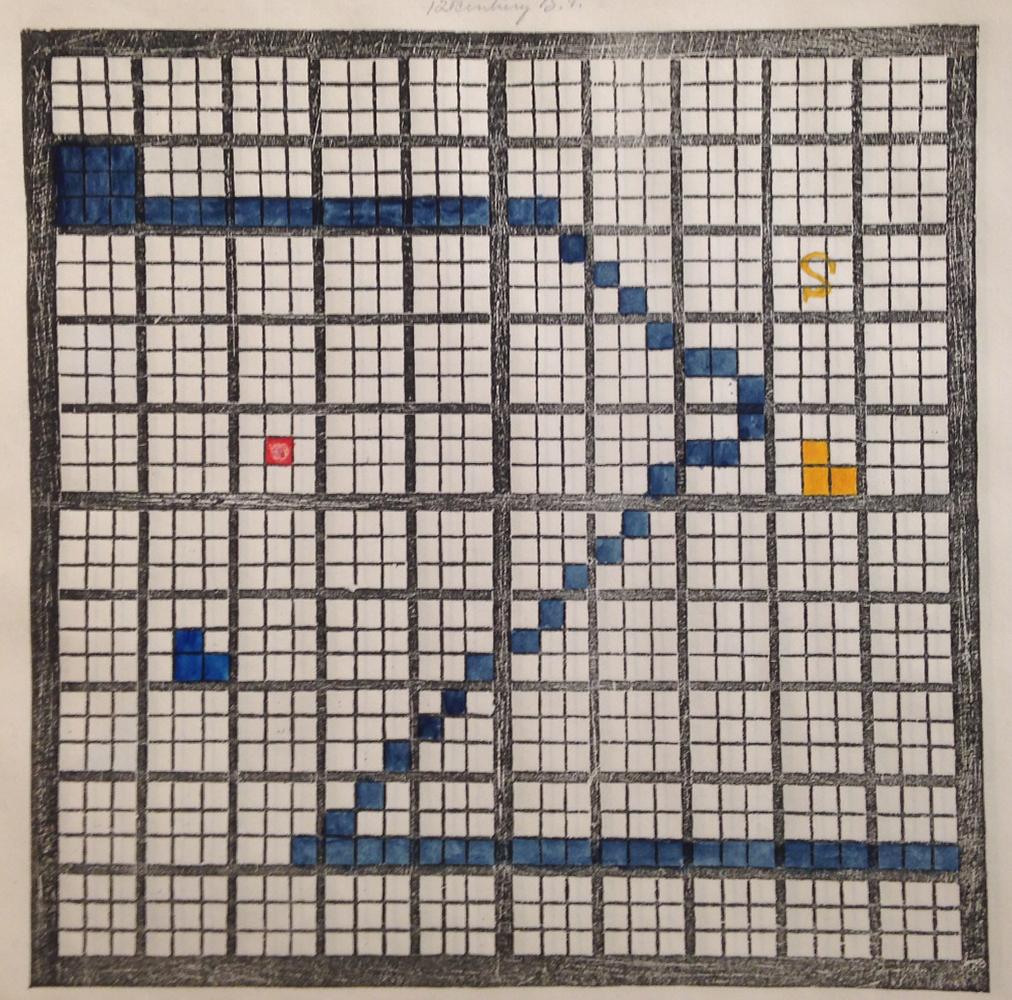
The Polish-American Systemhoused at the American Antiquarian Society. Courtesy of the American Antiquarian Society. Photos by Lauren Klein.

While sharply divergent from Peabody's charts in terms of visual form, Peabody nevertheless identified Willard as a major source of inspiration, crediting Willard with creating "the most ingenious chart ever besides [her own] invented."As for Willard, her stated influences included Joseph Priestley's New Chart of History, from 1796, among the most circulated charts of its time; and Playfair'sCommercial and Political Atlas, which we have already discussed in depth. According to historian Susan Schulten, Willard appreciated the efficiency of Playfair's charts, but felt that they gave "little sense of thedimension, such as the relative importance of periods or the subjective experience of time."From our vantage in the present, it is still safe to say that Playfair's import-export charts do not provide a sense of the subjective experience of time. But they remain just as interpretable today as they were at the time of their making—one of Playfair's primary aims, as you might recall.
By contrast, the more abstract impression first conveyed by Peabody's chronological grids requires additional interpretation. Her configuration of her data not according to the cartesian grid (pace Playfair) but instead as a visual text, designed to be read from left to right, top to bottom, underscores her interpretive intent. (What might seem to be x-y axes that divide each image into quadrants are instead, as Peabody explains, only intended to serve as visual anchor points in an otherwise unstructured field.) This, too, was intentional. Peabody designed her charts to serve as the basis for future knowledge, rather than that knowledge's definitive source.
With the addition of the workbooks, which enabled the students to create their own charts, Peabody underscores her belief in a more participatory form of knowledge production as well. Her requirement that we participate challenges the typical hierarchy of knowledge-making, in which the designer of a visualization is inherently above those who view (or interact) with it. According to Peabody's pedagogical process, it is the student who is authorized to both create and interpret the image, rather than the original designer—in this case, Peabody herself. If there is a single message that is communicated by Peabody's charts, it is that their meaning is not fixed. Rather, they impress upon the viewer a sense of responsibility—first for developing informed interpretations of the colors, shapes, and positions that they perceive, and then for designing their own course of future action.
An additional aspect of Peabody's participatory pedagogy were the “mural charts,” or “painted centuries” as she also sometimes described them, that she created in order to center classroom discussion. These were the charts she traveled with on her national promotional tour, as mentioned at the outset of this chapter, and by all accounts they were dazzling: triangles and squares of crimson, ochre, and forest green, set against a sharp black grid. In her version of a sales pitch, Peabody would “lay [a] chart down on the floor” and invite her would-be textbook adopters to sit around it and contemplate the colors and patterns they perceived.
The pedagogical impact of this embodied interaction was, as best we can gather, nothing short of transformative. “I have never known a system which placed the events of the history of all nations before the mind with such clearness, so little confusion, and so much permanency,” wrote Eliphalet Nott, then president of Union College, who participated in one of Peabody's teaching demonstrations.Anticipating a decidedly twenty-first-century view of the value of data visceralization, Peabody staged an encounter with the data that involved the whole body. This was an interaction that, she hoped, would in turn stimulate the imagination to new heights. Indeed, if visualization is to continue to offer “richer understandings [of data] that enable researchers to ask bolder questions,” as esteemed visualization researcher Ben Shneiderman asserts, then the mural chart seems to represent an early apotheosis.
And yet, because the mural charts were not valued as objects of knowledge in their own time, not a single one has been preserved.Scholars even remain uncertain as to many of their basic features. Peabody's biographer, Bruce Ronda, speculates that they “must have been much larger than even folio size.”And while he does not provide any more specificity, Peabody's nephew Julian's recollection of the “huge, colored charts” which “hung on the walls of our sitting room” offers a first-hand account of the impression they made.As an additional datapoint, one might consider the “poster-sized timelines” created by Peabody's contemporary, Anne Laura Clarke, who created her timelines with the help of her sister, also named Elizabeth, to accompany a series of lectures on history which she delivered across the country. (Clarke's charts were not acquired by an archive but instead kept in her sister's attic, where they remain today. )
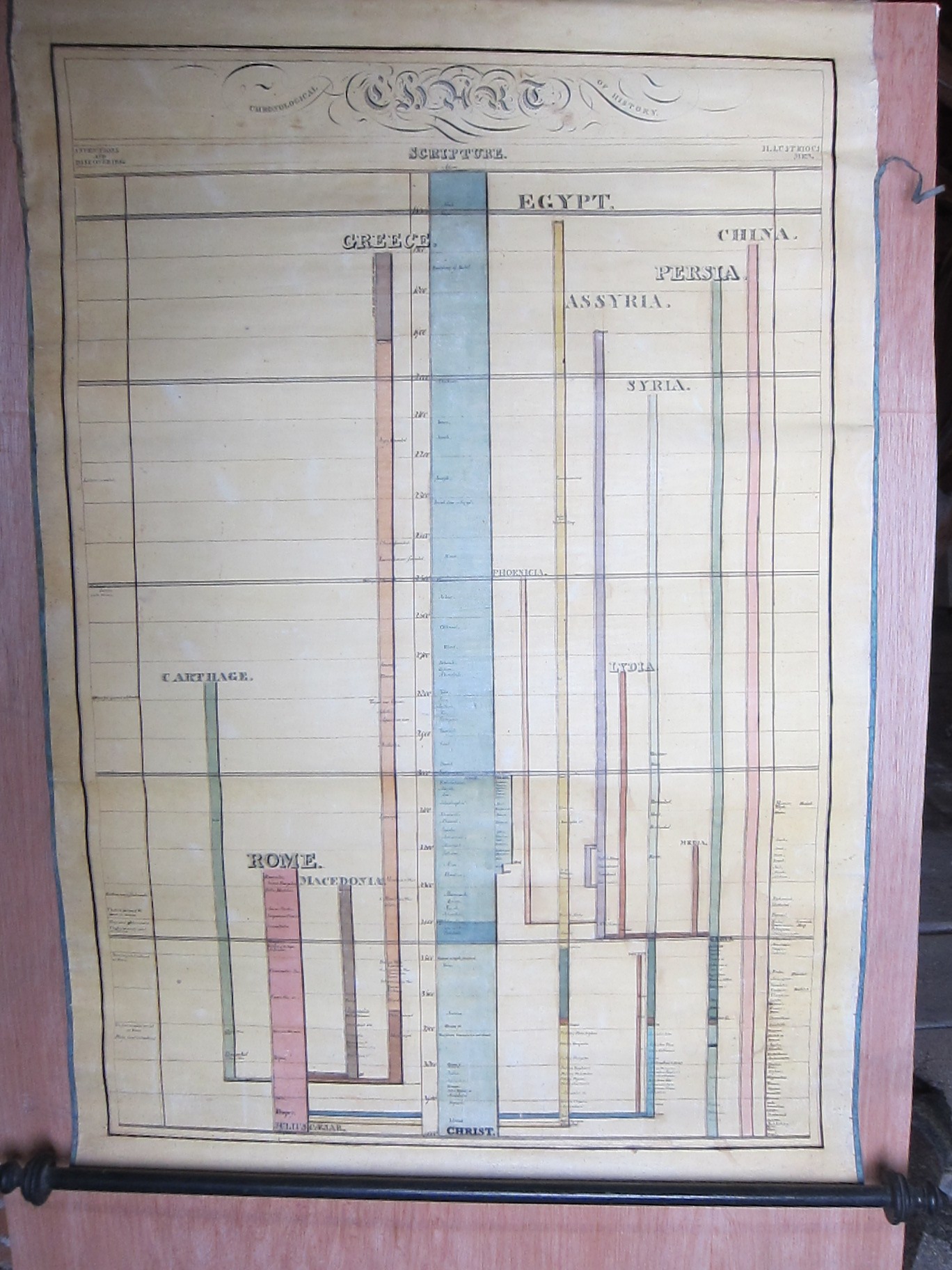
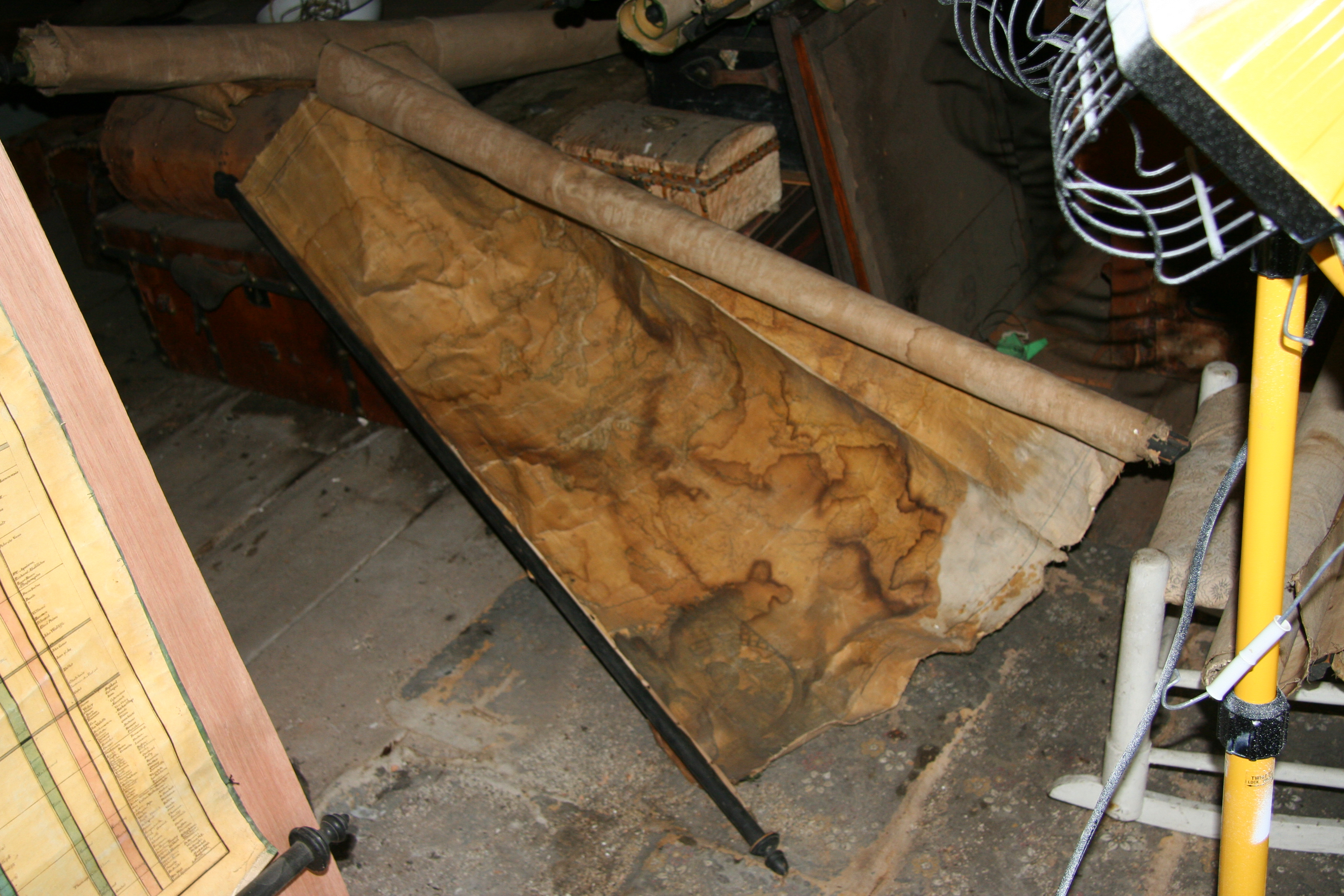
Left: One of the timelines created by Anne Laura Clarke, as explored by Granville Ganter in his essay on Clarke's traveling lectures.
Right: Another timeline as it was first encountered by Ganter. Photos by Granville Ganter. Courtesy of Granville Ganter.
The absence of Peabody's mural charts from the archive prompted me to reimagine Peabody's embodied pedagogy for the present.Working with my research group, in a team that involved multiple cohorts of students over multiple years, we first created a three-foot by three-foot touch matrix made of strips of copper tape.The matrix works like a computer keyboard, with columns and rows of conductive material--in this case, the copper tape--separated by foam spacer. When a person presses on a square of the grid, the two layers of copper tape touch each other, creating a connection. Above the touch matrix sits a cloth topper, also fabricated by members of the lab, that approximates the visual features of Peabody’s original charts.The topper holds in place a series of strips of individually addressable LEDs, resulting in a 30 x 30 grid that can be programmed to display her “painted centuries.” While Peabody used a stick to point to specific events on the grid, our “Floor Chart,” as we named our project, responds to touch; users can press on individual squares in order to cycle through the possible colors of each chart, allowing them to engage multiple senses in the creation of chronological charts of their own.
The Floor Chart project required expertise in a range of domains, from electronics prototyping to signal processing to circuit board design. It also required a truly tremendous amount of physical labor. Each yard-long strip of copper tape needed to be perfectly aligned, lest a small misalignment at one end result in a significant gap at the other. Each of the nine-hundred square-shaped holes of the membrane layer of the touch matrix was required to be cut out by hand, as laser-cutting the holes would have released harmful toxins. Each electrical connection was required to be soldered, tested, and then—in almost all cases—soldered again, to ensure that the circuit remained intact. As much as an exercise in physical fabrication, the project became an exercise in the physicality of work itself—of the focus that is required, and the resultant fatigue, of any large-scale project that is made by human hands.

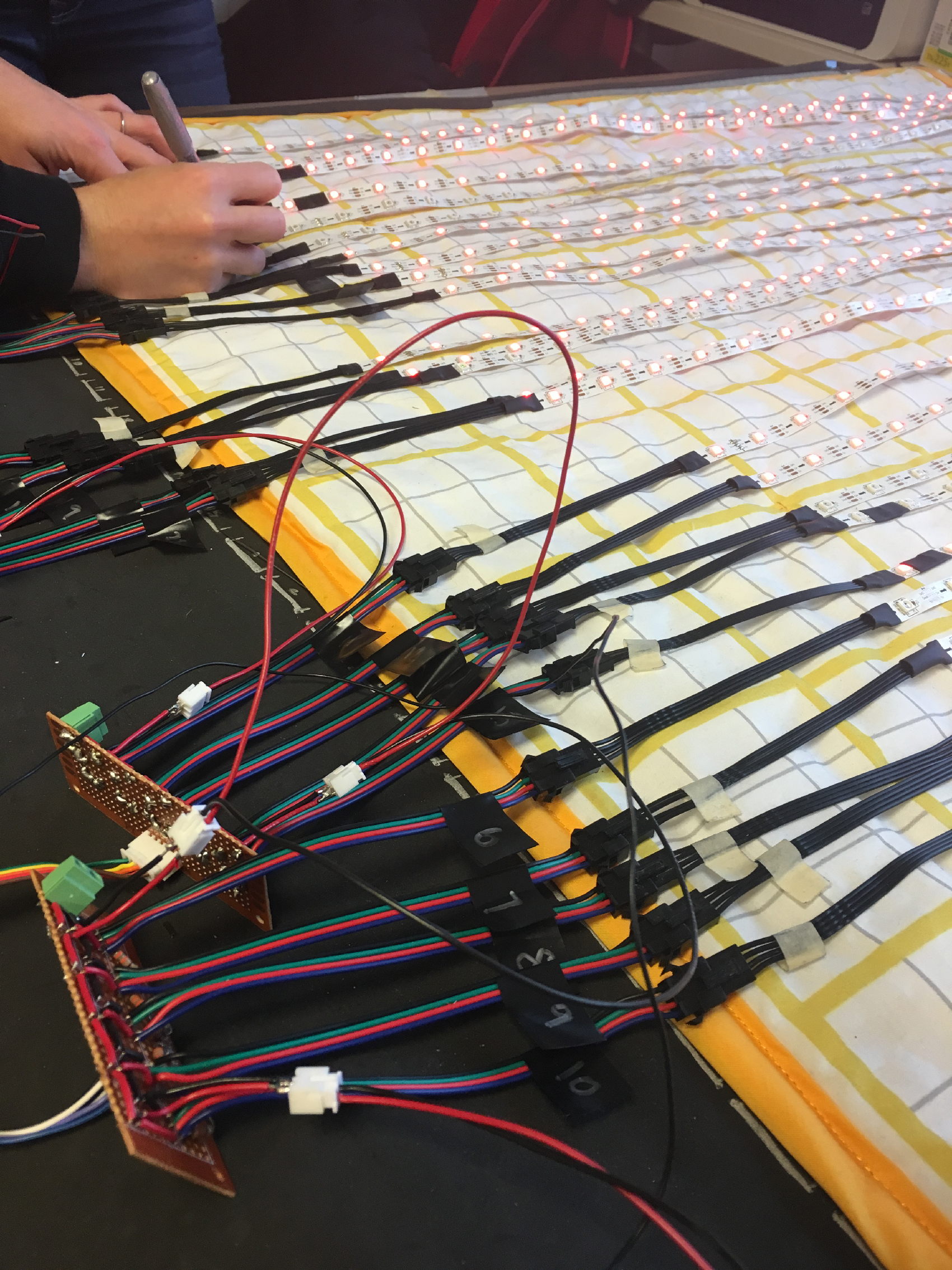

The layers of the touch interface, built with copper tape and a foam spacer; the assembled touch interface; a view of the modular circuit boards for communicating with the LEDs; a rendering of the completed Floor Chart; the LEDs displayed on top of the quilted chart. Photos by Lauren Klein.
The tedious, time-intensive nature of the Floor Chart project provides another path of connection back to Peabody's original mural charts. For she did not only demonstrate the charts as part of her sales pitch; as an additional incentive, she also promised an original mural chart to any teacher who purchased copies of her textbooks for their entire class. Writing to a friend in 1850, Peabody revealed that she was “aching from the fatigue of making Charts for the Schools who will take the book.” The letter continues:
Every school must have a mural chart—& there is but one way of making them (until they can be made by ten thousands) & that is by stenciling [sic]... I can do one a day. But I must sell them cheap… To day I worked 15 hours—only sitting down to take my meals—& so I have done all week—so much fatigue stupefies one—but as soon as it is adopted in a few towns I shall be able to hire someone to do this drudgery for me.Elizabeth Peabody,Letter to Samuel Gray Ward, September 1850
While we cannot change the fact that we no longer have access to the mural charts themselves, letters like these help to attest to the physical labor that was required to produce them. With its reference to the “stencilling” through which Peabody created her colorful symbols, as well as to its characterization of the tasks involved as “drudgery,” the letter also exposes the gendered dimensions of Peabody's knowledge work.
It's not a coincidence that the fabrication of the mural charts involved what is now plainly legible as “women's work,” and that these same charts were not preserved. Then as now, the status hierarchy of work aligns with the social hierarchy of gender, at least in an Anglo-Western context. Work that is performed outside the home is valued, both culturally and monetarily, over work that is performed within it. Work that is perceived as more rigorous, or more professional—like, for instance, the political economy that functioned as Playfair's primary trade—is valued, again, both culturally and monetarily, over work that is perceived as more intuitive, or more domestic—like, for instance, the teaching that functioned as Peabody's main employ. Even within the art world, creative work that is perceived as high art is valued above work perceived as craft.
These gendered divisions of labor are among the primary reasons that Peabody's mural charts never entered the archive. And they are the same reasons that her charts have not (yet) been centered in the account of the rise of modern data visualization that is most commonly told. But who else are we missing when we fail to include examples like these in the stories we tell about the emergence of data visualization? And what possible future approaches to visualization design are we foreclosing, either intentionally or inadvertently, when we do?
It is now uncontroversial to assert that the work of women has been crucial to the development of most scholarly disciplines and professional fields, even if the value of that work is still often only recovered after the fact. While the obvious turn, here, may be to the women “computers” who were the first computer programmers, I would like to retain a focus on the charts' formal innovation. To wit: most contemporary viewers, when seeing Peabody's charts for the first time, observe that they look like paintings by Piet Mondrian, the famous Dutch modernist. To be sure, Peabody's charts strongly resemble Mondrian's own bold, colorful, geometric grid. But Peabody's self-account of the work involved in making the mural charts brings to mind a second point of reference, which is not painting but quilting: an artform traditionally practiced by women, and that has long been relegated to the world of “folk art” and craft.
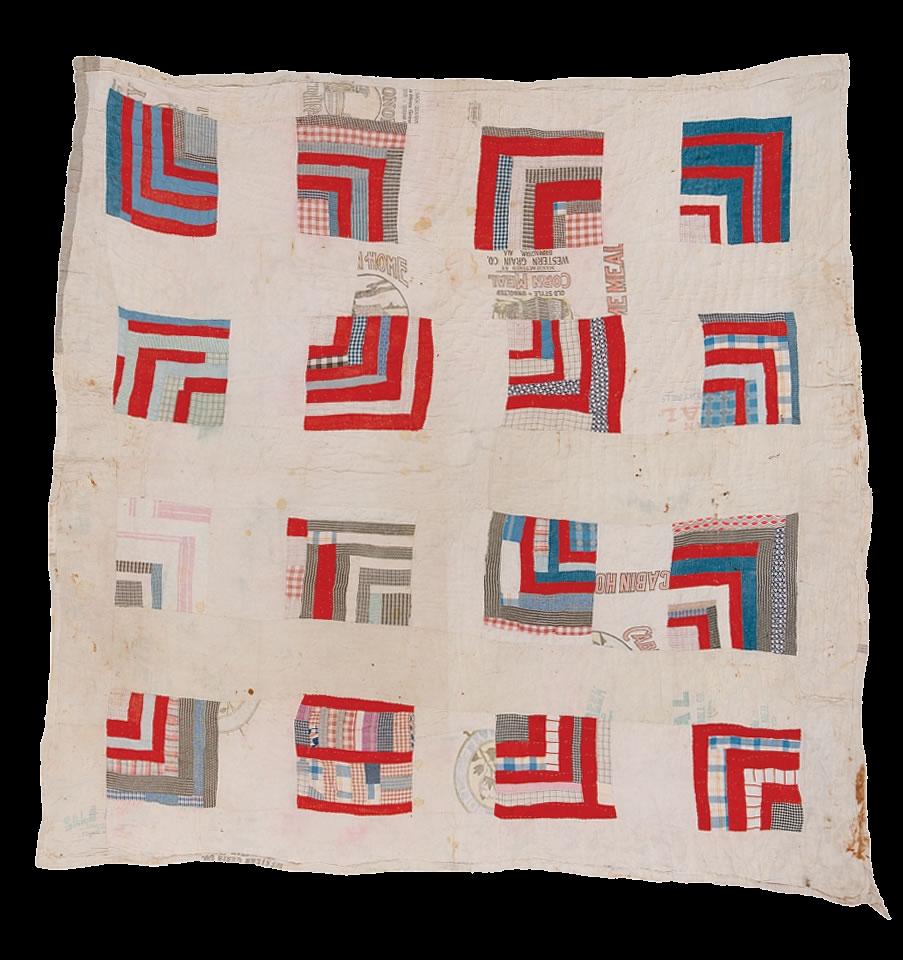
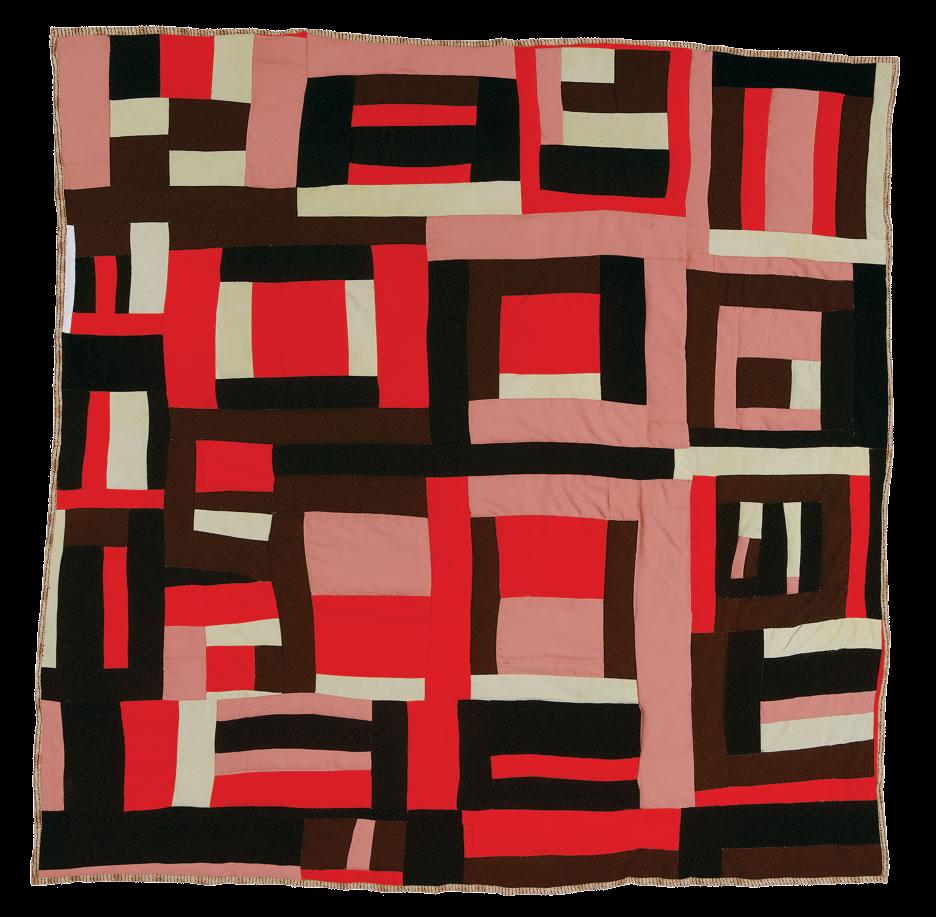
Left: "Housetop," by Rachel Carey George, ca. 1935.
Right: "Housetop" variation, design by Mary Lee Bendolph. 1998, quilted by Essie Bendolph Pettaway, 2001. Photos courtesy of Tinwood Media.
Permissions pending.
Pictured above are two quilts from the area of Alabama known as Gee's Bend, a small, rural Black community, 35 miles south of Selma, that can trace its roots to a cotton plantation that was established there in the early nineteenth century. While valued by the residents of Gee's Bend for centuries, both for their formal features and for the family histories that they encode, the quilts have only recently begun to be recognized by art historians as key contributors to the development of modernist art.Exhibitions at the Whitney Museum in New York, in 2002; the Turner Contemporary in London, in 2019; and others, have confirmed how the quilts "predate like-minded works by their more famous abstract art cousins."
As Black women who pursued their art while enslaved, and have continued to persist through slavery's perpetual wake, the life experiences of the Gee's Bend quilters could not be farther removed from those of Peabody, a white woman protected by her family's membership in Boston's intellectual elite. But the creative work of the Gee's Bend quilters, as distinguished historian Elsa Barkley Brown has shown, offers a model that can help to bring together these complementary perspectives. Drawing inspiration from their “polyrhythmic, 'nonsymmetrical,'' and nonlinear” patterns, Barkley Brown advocates for a continual “pivoting” of the center—that is, not decentering one perspective in favor of another but instead intentionally and continually shifting the focus from one perspective to the next. The result of this strategy, which Barkley Brown devised for her own history classroom, is capacious and multifold: it allows the artifacts and experiences under analysis to be understood in the context of their own creation, and it allows the students performing this interpretive work to “become the voices of authority in their own education.” Ultimately, Barkley Brown concludes that when done right, “the class is a quilt. It is precisely the contrast which organizes the whole and holds it together.”
We might similarly come to understand history as a quilt—as Brown strongly implies and as our project team has literally fabricated. But our work—and now I speak as a "we" in the general sense, on behalf of scholars of data visualization and those who design them—is far from complete. Consider the surprise that greeted me—along with no small degree of pleasure—upon discovering that a quilt created by Loretta Pettway, one of the Gee's Bend quilters, graces the cover of Edward Tufte's most recent book, Seeing with Fresh Eyes(2020). More than merely a compelling image—"unorthodox, fresh, amazing" is the extent of how Tufte describes it in the text—we must learn to see Pettaway's quilt, like Peabody's chart, as a system of knowledge making.These two systems of knowledge-making, moreover, helpfully converge. Both employ shape and color in order to represent and recall past events: the quilts in order commemorate a community's ancestors and their stories; and the charts, as we have learned, in order to craft new narratives about the nation's defining historical events. Both also rely upon sense perception—and more specifically, the tactile experiences of the body—in order to assimilate visual display into knowledge. Whether enveloping oneself in a quilt, or gathering together around a mural chart, the result is a more immersive encounter with the object—and with the events of the past that the object seeks to commemorate, on the one hand; or on the other, convey.
Barkley-Brown reminds us that these quilts are "illustrative of a particular way of seeing, of ordering the world."We might extend this assertion to data visualization. The images and interactions that we create reflect our own ways of seeing and ordering the world. This fact does not invalidate the insights that they prompt, or the knowledge that they help us to acquire. On the contrary, it informs the knowledge that any particular visualization helps bring to light. With a wider awareness of the multiple ways of seeing the world, and a wider range of methods for ordering its data, we can enrich the basis of what we presently know, and—as Peabody envisioned—open up new possibilities for future knowledge.
Since the outset of this project, I have argued for the additional inspiration we might find, and the knowledge we might gain, by expanding the history of data visualization to include a wider range of forms and figures. From Peabody and from the Gee's Bend quilters, we are pointed to the meaning-making capacity of geometric abstraction, and to the epistemological possibilities of more immersive—and more prolonged—visualization experiences. We are also pointed to the possibilities opened up by placing visualization midway through the process of knowledge production, rather than at its end, as we are to questions about who is authorized to produce knowledge from the start. Here we might expand Peabody's view of the value of bringing together multiple perspectives, enhanced by the example of the Gee's Bend quilts, into a broader claim about the need to expand the range of sources—and the range of people—who we enable, as visualization designers, to make knowledge claims. Following the theories and approaches of the scholars introduced in this chapter, including Donna Haraway, Katherine McKittrick, and Elsa Barkley Brown, we might employ Peabody's pedagogy in our own work as a path to understanding the situated and relational nature of all that we know.
Finally, we might employ Peabody's data creations—both the textbooks and workbooks that are preserved in the archive, and the mural charts that are not—in order to reflect upon the range of labor that is involved in knowledge work, and the range of people who perform it. As we move into the final chapter of this book, which centers on the charts that W.E.B. Du Bois and his students designed for the 1900 Paris Exposition, we will continue to explore how we might value the full range of labor that contributes to the creation of data visualizations, how we might honor all of those we rely upon to perform this work, and how we might ensure that their contributions are no longer erased from history. As we move forward in time, Peabody's visual method becomes valuable once again, because it authorizes us as viewers, as students, as designers, and as researchers, to fill in the details of the stories that we can only perceive in the abstract. Peabody's hope, which we might carry forward, is that when presented with the outlines of history, we might take it upon ourselves to color them in.
Play
The Peabody Chart for fun
How to play
Conceptual takeaways
- Commit to a capacious definition of what counts as knowledge
- Commit to a capacious definition of what counts as visualization
- Consider who might be missing from the field of visualization
- Consider the reasons why
Practical takeaways
- Focus on supporting the process of knowledge production
- Enable interactions among multiple representational forms (text, image, etc)
- Consider alternatives to ease and efficiency
- Consider modes of representing data beyond the visual form